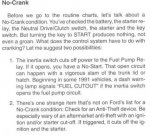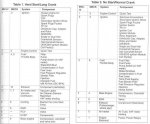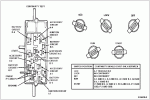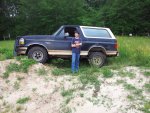yo,
Have them do a Self Test for Diagnostic Trouble Codes (DTC)s by my pal, BroncoJoe19
http://broncozone.co..._mode__threaded
http://broncozone.com/topic/14269-code-reader/page__pid__74587__mode__threaded
The engine temperature must be greater than 50° F for the Key On Engine Off (KOEO) Self-Test and greater than 180° F for the Key On Engine Running (KOER) Self-Test.
Run it around to heat the engine up and shift thru all gears incl Reverse. Then turn off all accessories/lights, etc.
Make sure A/C is off and transmission is in Park (automatic) or in Neutral for a Manual & release clutch.
Do Key On Engine Off (KOEO) portion first.
Look Codes up in my broncolinks.com site using the new Search function.
And Post em here according to:
KOEO
&
KOER
and then ask them to look @ this to help them give us more details (I have an awful headache due to the pollen; worse iin many years)

by Charlie Probst
then have them look @ this;

by Charlie Probst
-----------------
No Crank, Starter Relay Clicks/Buzzes; "...It can click/buzz from several causes:-A weak battery. Not enough juice to crank it once the solenoid closes. Buzz. Bad cables. Look for swollen places in the insulation, white or green dust/corrosion, worn or burnt places, stiff sections, or relay is loose (check for corrosion/rust between relay body and fender liner; tighten bolts holding it to passenger side fender liner), etc.
See pic E. If you replace them, try to get a larger diameter cable. Stock is typically 4 gauge, changing to a 2 or 0 gauge will pay off in the long run. Loose cables. Negative from the battery where it attaches to the engine is a common location, but check them all. Dirty cable connections. Don't just clean the outside, clean where the cable contacts the post & where the other end connects too. Cheap clamp on ends. See pics D & E below.
http://www.hotrodwires.com/cart/images/products/BatteryCableTop1cRev-lg.jpg
http://img100.imageshack.us/img100/129/c110100153202.jpg
No Crank; "...For an engine-won't-crank condition with an automatic transmission, determine if the condition exists with the shift control selector level in both PARK and NEUTRAL positions before performing the ignition switch continuity tests.
If the no-crank condition occurs in one shift lever position but not the other, a more probable cause is the Manual Lever Position (MLPS) located on driver's side of transmission case.
Ignition Switch Pin-Out Diagram & Continuity Testing (Logic Tables); Disconnect ignition key warning switch terminal and wire from the ignition switch.
Test the continuity of the ignition switch as described in the following illustrations.
Connect a self-powered test lamp or ohmmeter between the blade terminals indicated on the chart.
No continuity between any blade and chassis ground should exist in any ignition switch position except the proof Circuit 41 (BK/LB) (Pin P1) and Circuit 512 (T/LG) (Pin P2) in the START position only.
NOTE: Ignition Switch Mechanical Test: Accessories that fail to operate with the key in RUN, or that remain on when the key is turned off, may be the result of a misadjusted ignition switch rather than a malfunctioning ignition switch.
Refer to Ignition Switch in the
Adjustments portion of this section.
Do not apply lubricant to the inside of the ignition switch.
Test the steering column ignition system mechanical operation by rotating the ignition switch lock cylinder through all positions of the ignition switch. The movement should feel smooth with no sticking or binding.
The ignition system should return from the START position back to the ON position without assistance (spring return). If sticking or binding is encountered, check for the following: burrs on the ignition switch lock cylinder; binding ignition switch lock cylinder; shroud rubbing against ignition switch lock cylinder; burrs or foreign material around the rack-and-pinion actuator in the housing of the ignition switch lock cylinder; insufficient **** on actuator; binding ignition switch..."

No Start Troubleshooting; "...If you can't start the Bronco from the key/cylinder it might be the "upper ignition actuator" has broken in it's track inside the steering wheel OR could be just the key cylinder itself which "pops out" if you look right under it on the metal column collar, there's a little slot and with the key turned to RUN -engine off push up inside with an appropriate tool and comes right out. You can either jump start the vehicle from the "starter relay" under the hood, right inside fender area or pull off the "black plastic cosmetic column shroud" exposing a long 'ROD" and with the key turned to RUN using a set of pliers, drive the ROD downward/forward and the vehicle will start with most key functions intact....i.e, RUN/NO START, OFF/LOCK, AUX..."
Source: by JKossarides ("The Bronco", Jean)
Actuator (Upper & Lower) pics in 92-96 w/Out Tilt; Ford pn F2DZ 3E723 A, "Upper plastic ignition actuator gear with teeth often breaks prevents you from starting or shutting off the vehicle with the ignition key. The ignition rack actuator failure if often misdiagnosed as a ignition lock or ignition switch problem..." miesk5 Note, pn F0DZ 3E715 A is Lower actuator rod; This piece is actually what joins with the ignition switch to start the Bronco. It is pushed by the ignition lock cyliner and upper rack gear.
Source: by steeringcolumnservices.com @
http://www.steeringcolumnservices.com/ford/ignition-actuators.php
MORE Switch & Actuator info LINKs in my site @
http://www.broncolinks.com/index.php?index=225
No Start Troubleshooting but Starter Cranks Engine in 4.9, 5.0, or 5.8L; "....TIP 1: Since a lot of folks confuse a No Crank Condition with a No Start Condition... I'll clear it up right now: In a No Start Condition means your vehicle's Starter Motor is cranking the Engine but the Engine is not starting. In a No Crank Condition, the Engine is not cranking when you turn the key to crank the Engine. This article only deals with a No Start Condition..." read more
Source: by easyautodiagnostics.com
http://troubleshootmyvehicle.com/ford_no_start_4.9L_5.0L_5.8L/diagnose_no_start_1.php
Only good for a trail fix to get you to the store to buy a real cable. -A bad solenoid (Yeah, I said solenoid. Call it a starter relay if you want. I'm old. We've always called it a solenoid, so there. Solenoid, solenoid solenoid). A loose starter that hangs up against the flywheel when it tries to crank. It jams, overloads & drops the voltage. A bad starter. Many auto parts stores will test them. A frozen engine. Serious breakage inside, hydrolocked, rusted solid, badly broken trans keeping the engine from rotating, etc. If you've had both grinding & buzzing, check the starter mounting bolts, since loose bolts can cause both..."
Source: by ElKabong (Ken, El Kabong)





